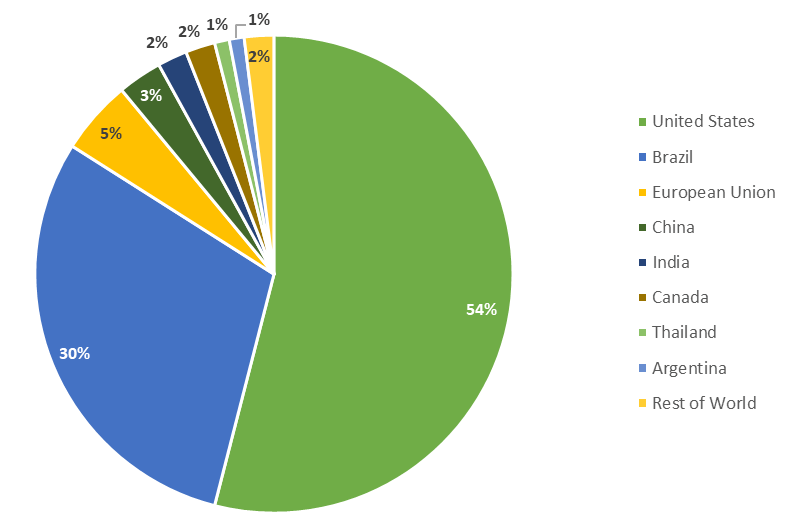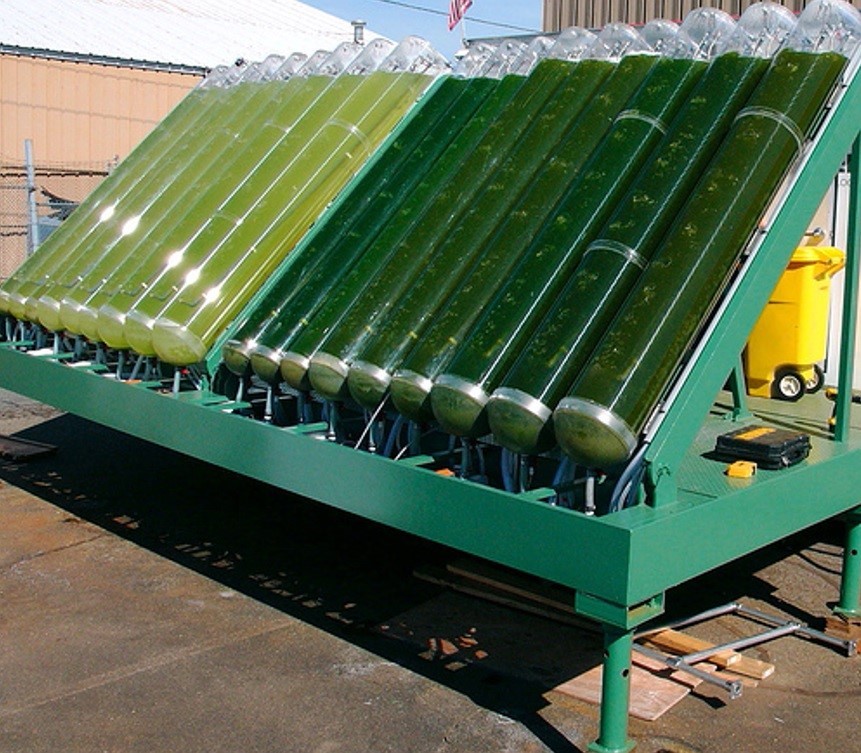Biofuels are liquid fuels made from biomass (plant or animal organic materials) and used primarily in transportation, which is almost entirely dependent on fossil fuels. The difference between biofuels and fossil fuels is that biofuels are made directly from living renewable materials whereas fossil fuels are made from the remains of dead organisms that have broken down millions of years ago (not a renewable source in the short term of the universe). The two most common and commercially available biofuels are ethanol and biodiesel. These two fuels are the first generation of biofuels and are typically made from sugar crops (sugarcane), starch crops (corn, sorghum), oilseed crops (soybean, canola), and animal fats. Second-generation biofuels -cellulosic biofuels – are made from the cellulose of non-food crops and waste biomass such as corncobs, straw, wood, and wood byproducts. And lastly, third-generation biofuels, which are not yet commercially available, are made from algae.
First-generation biofuels have been around for a long time. In fact, in the US, ethanol has been used as a fuel without interruption since 1933. In 1900, Rudolf Diesel (inventor of the Diesel Engine) demonstrated a model engine that ran entirely on peanut oil. Biofuels have received increased attention over the last two decades, as societies around the world strive to diversify their energy portfolios and address environmental degradation concerns.
There is a clear interest in the production of biofuels in many countries around the world. But what exactly are ethanol and biodiesel? What are the implications of their production and consumption? And where does Canada stand with its biofuel policies?
Ethanol
Ethanol is an alcohol that can be produced from feedstock in several ways, the most common being fermentation. Typically, ethanol is blended with gasoline to produce a fuel that has environmental advantages (burns cleaner) compared to gasoline alone. However, ethanol does have a lower energy density than gasoline. Specifically, the energy per unit volume of ethanol is 34% lower than that of gasoline. To get a better idea of this, you would need 1.5 gallons of ethanol to produce the same amount of energy from 1 gallon of gasoline. Despite this, ethanol does have a higher octane level than gasoline. This means that as the energy contained in ethanol is converted into mechanical energy (the energy used to move a vehicle by combustion), less energy from ethanol is wasted compared to gasoline.
In Canada, most gasoline-powered vehicles can run on a blend consisting of gasoline and up to 10% ethanol. According to the Renewable Fuels Regulations, fuel imported or produced in Canada must have an average renewable fuel content of at least 5% based on the volume of gasoline produced or imported, and at least 2% based on the volume of diesel fuel and heating distillate oil produced or imported.
According to the Renewable Fuels Association, the US is the world leader in the production, consumption, and export of ethanol (54% of total global production), and Brazil and Canada are the top two destinations of US ethanol exports. The top 10 world ethanol producers are presented in Figure 1.

Source: 2020 Ethanol Industry Outlook p. 7
Biodiesel
Biodiesel is a diesel fuel substitute that can be used in diesel engines. It is typically made from renewable materials that are transformed into biodiesel through a process called transesterification, a chemical process that converts fats and oils into fatty acid methyl esters. The energy density of biodiesel is comparable to that of gasoline and petrodiesel. The most common biodiesel-petrodiesel blends are:
- B2: 2% biodiesel mixed with 98% diesel
- B5: 5% biodiesel mixed with 95% diesel
- B10: 10% biodiesel mixed with 90% diesel
- B20: 20% biodiesel mixed with 80% diesel
- B100: 100% biodiesel with no diesel content
B20 is the best blend rate because it burns cleaner than petrodiesel and has better flow properties at low temperatures than pure biodiesel, which would clump up in the cold. While B100 is not a commonly used fuel, its energy output is 8% less than pure diesel, whereas the energy difference is virtually unnoticeable with B5 or lower.
Implications of Biofuel Production
Biofuel production and consumption are not without their critics, practically all of its supposed benefits have been called into question. To understand why it’s necessary to look at how biofuels are produced. The logical starting point is with the world’s largest producer.
In the US, an average of 38 million acres of land a year (15.4 million ha), an area larger than the state of Illinois (¼ the size of Saskatchewan), are cultivated with corn to produce ethanol. The Renewable Fuel Standard (RFS), an energy policy intended to diversify energy sources and reduce carbon emissions, has the goal that by 2022, 35 billion gallons (160 billion liters) of ethanol-equivalent biofuels and 1 billion gallons of biomass-based diesel must be consumed in the US. This target is unlikely to be met. Even if that target was met, it is unlikely to reduce greenhouse gas emissions because reductions depend on how biofuels are produced.
A large amount of fossil fuel is required to produce, grow, harvest, transport, and process a gallon of ethanol, eating up much of the difference in carbon emissions between ethanol and gasoline alone. A 2009 study by the Congressional Budget Office found that “the demand for corn for ethanol production, along with other factors, exerted upward pressure on corn prices, which rose by more than 50 percent between April 2007 and April 2008. Rising demand for corn also increased the demand for cropland and the price of animal feed.” In the US, producing ethanol has had unintended effects on feed price ( and therefore also on meat price for consumers) and sends signals to farmers to produce corn (competing with the production of other crops). These issues persist today.
What is the biofuel picture in Canada?
The Canadian government has proposed rules for its Clean Fuel Standard (CFS), which are now in a 75-day comment period. If adopted they would come into force in 2022. The objective of the CFS “is to achieve 30 million tonnes of annual reductions in greenhouse gas emissions by 2030, … reducing national emissions by 30% below 2005 levels by 2030.” In 2005, Canada emitted 729 megatonnes of carbon dioxide equivalent (Mt CO2 eq).
The table below provides an overview of existing biofuel mandates in Canada.

With the pursuit of biofuel policies, it is thought they will provide a practical opportunity to achieve multiple objectives: reduce GHG emissions, increase economic opportunities for rural communities, improve air quality, and accelerate the development of next-generation biofuels.
What has happened with the current set of Canadian biofuel policies (not considering the CFS, just fuel mandates)?
The Canadian biofuels industry is diffuse, with many small producers that claim biofuels as their sole business. And according to Canada’s Ecofiscal Commission (CEC), a fiscal policy focused non-governmental organization, biofuel policies in Canada have had limited success at high costs. The CEC estimates that between 2010 and 2015, an annual average of 3 megatonnes of GHG emissions were reduced due to the adoption of biofuels blend mandates. To contextualize this number, Canada’s total GHG emissions in 2018 were 729 megatonnes of carbon dioxide equivalent (Mt CO2 eq). According to the CEC, the reduction of 0.4% of total Canadian GHG emissions has cost (in both fiscal and consumer cost terms) approximately $180 to $185 per tonne with ethanol policies, and $128 to $165 per tonne with biodiesel policies.
Conclusion
The production and consumption of biofuels have uncovered the complex links between land use, the food sector, and global energy policies. Carbon emissions must be reduced. However, it is unclear thus far that the impacts of biofuels justify their addition to the portfolio of climate change mitigation tools. In the US, the production and consumption of biofuels is a very contentious issue, and their environmental benefits have not materialized in the way hoped. Canada is also moving towards the implementation of regulations on biofuels. The biofuel policies adopted so far have reduced GHG emissions at a very high cost. More research is needed to understand the economic, fiscal and environmental impacts the CFS will have.


